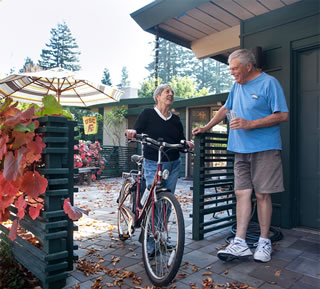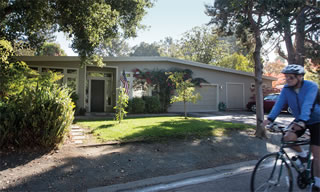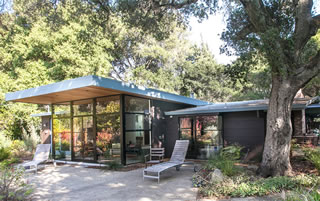Menlomorphosis - Page 2
 |
|
|
|
|
 |
 |
|
|
 |
|
|
Danforth’s house was once one of four Eichlers in a mini-subdivision. Today it’s the only one intact.
When he bought it from the family of the second owner, he says, “Of the eight or nine bids, I was the only one who wanted to keep it,” Danforth says. “I loved the house and garden,” he told the owners. “I want to live there.”
The argument worked. “They said, ‘We could have a bidding war, but we’ll sell it to you,’” Danforth says. “The neighbors were overjoyed.” Danforth has added a 400-square-foot addition in back but has otherwise preserved the home as an original Eichler.
In part, the challenges facing Eichler homes in Menlo Park trace back to the way they were built—in small to medium-sized clusters, and often hidden clusters at that, and as the occasional stand-alone, semi-custom home.
Many of the approximately 50 Eichlers remaining in town are invisible from the street. Two or three of them are often clustered together at the end of long driveways known as ‘flag lots’ because of their shape, with the driveway serving as the flagpole.
Just how hidden are they? For years, Cesar and Hildy Agustin would take their children Diego and Isabel to Peninsula School, a private school in a purportedly haunted mansion that sits directly across from a group of Eichler homes on Peninsula Way. The Agustins, proud Eichler owners on the other side of town, never spotted the Eichlers on Peninsula Way.
Since the Eichler neighborhoods tend to be small (Stanford Gardens, the largest, has fewer than 20 homes; Oakdell Park, the second largest, originally had 16), they lack the power of numbers and strong sense of community.
“We don’t really know the other Eichler people who live beyond this cul-de-sac,” says Cesar Agustin, who lives in a four-Eichler cluster near Stanford Gardens. “It’s not like South Palo Alto, where all the people congregate. We know the people who are trying to save each other’s houses.”
Still, in some ways, the Eichlers of Menlo Park are among the most interesting of all Joe Eichler’s homes. In Menlo Park you can see some of his earliest homes—those of Stanford Gardens, designed by an unknown designer before Eichler hired his first architects. They sit across the street from some of Eichler’s last homes.
Those would be the cluster of dramatic, steep-gabled homes designed by architect Claude Oakland, where the Agustins live on Stanford Avenue.




